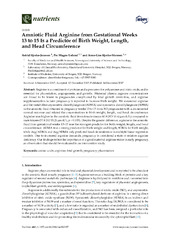| dc.contributor.author | Jenssen, Astrid Bjørke | en_US |
| dc.contributor.author | Ueland, Per Magne | en_US |
| dc.contributor.author | Monsen, Anne Lise Bjørke | en_US |
| dc.date.accessioned | 2019-04-26T11:05:26Z | |
| dc.date.available | 2019-04-26T11:05:26Z | |
| dc.date.issued | 2017-12-14 | |
| dc.Published | Jenssen, Ueland PM, Monsen ALB. Amniotic fluid arginine from gestational weeks 13 to 15 is a predictor of birth weight, length, and head circumference. Nutrients. 2017;9(12):1357 | eng |
| dc.identifier.issn | 2072-6643 | |
| dc.identifier.uri | https://hdl.handle.net/1956/19408 | |
| dc.description.abstract | Arginine is a constituent of proteins and a precursor for polyamines and nitric oxide, and is essential for placentation, angiogenesis, and growth. Maternal plasma arginine concentrations are found to be lower in pregnancies complicated by fetal growth restriction, and arginine supplementation in later pregnancy is reported to increase birth weight. We measured arginine and the metabolites asymmetric dimethylarginine (ADMA) and symmetric dimethylarginine (SDMA) in the amniotic fluid obtained in pregnancy weeks 13 to 15 from 363 pregnancies with a documented normal outcome and related the concentrations to birth weight, length, and head circumference. Arginine was higher in the amniotic fluid from female (mean 40.8 (SD 10.6) µmol/L) compared to male fetuses (37.4 (SD 11.2) µmol/L, p = 0.003). Despite the gender difference, arginine in the amniotic fluid from gestational weeks 13–15 was the strongest predictor for birth weight, length, and head circumference. ADMA was a strong predictor for birth weight and length, SDMA for birth weight, while Arg/ADMA and Arg/SDMA only predicted head circumference in multiple linear regression models. Due to increased arginine demands, pregnancy is considered a state of relative arginine deficiency. Our findings reflect the importance of a good maternal arginine status in early pregnancy, an observation that should be evaluated in an intervention study. | en_US |
| dc.language.iso | eng | eng |
| dc.publisher | MDPI | eng |
| dc.rights | Attribution CC BY | eng |
| dc.rights.uri | http://creativecommons.org/licenses/by/4.0 | eng |
| dc.subject | amino acids | eng |
| dc.subject | arginine | eng |
| dc.subject | fetal growth | eng |
| dc.subject | Pregnancy | eng |
| dc.subject | placentation | eng |
| dc.title | Amniotic fluid arginine from gestational weeks 13 to 15 is a predictor of birth weight, length, and head circumference | en_US |
| dc.type | Peer reviewed | |
| dc.type | Journal article | |
| dc.date.updated | 2018-08-16T08:08:05Z | |
| dc.description.version | publishedVersion | en_US |
| dc.rights.holder | Copyright 2017 The Authors | |
| dc.identifier.doi | https://doi.org/10.3390/nu9121357 | |
| dc.identifier.cristin | 1563550 | |
| dc.source.journal | Nutrients | |

